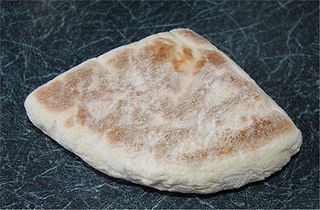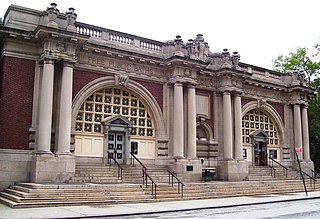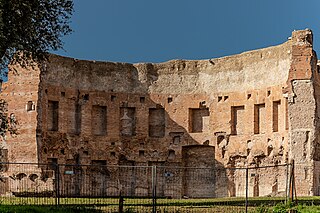
Lavandula is a genus of 47 known species of perennial flowering plants in the mints family, Lamiaceae. It is native to the Old World, primarily found across the drier, warmer regions of mainland Eurasia, with an affinity for maritime breezes.

Ghee is a type of clarified butter, originating from India. It is commonly used for cooking, as a traditional medicine, and for Hindu religious rituals.

Sentō (銭湯) is a type of Japanese communal bathhouse where customers pay for entrance. Traditionally these bathhouses have been quite utilitarian, with a tall barrier separating the sexes within one large room, a minimum of lined-up faucets on both sides, and a single large bath for the already washed bathers to sit in among others. Since the second half of the 20th century, these communal bathhouses have been decreasing in numbers as more and more Japanese residences now have baths. Some Japanese find social importance in going to public baths, out of the theory that physical proximity/intimacy brings emotional intimacy, which is termed skinship in pseudo-English Japanese. Others go to a sentō because they live in a small housing facility without a private bath or to enjoy bathing in a spacious room and to relax in saunas or jet baths that often accompany new or renovated sentōs.

Muesli is a cold Swiss breakfast dish, the primary ingredient of which is rolled oats. Traditionally, it is set to soak overnight and eaten the next morning. Additional ingredients, such as grains, nuts, seeds, and fresh or dried fruits are sometimes added, along with milk or cream, a small amount of citrus juice, and honey to add sweetness. Yoghurt, other milk products, or milk substitutes are now commonly added to both homemade and commercially packaged muesli recipes.

In ancient Rome, thermae and balneae were facilities for bathing. Thermae usually refers to the large imperial bath complexes, while balneae were smaller-scale facilities, public or private, that existed in great numbers throughout Rome.

Soda bread is a variety of quick bread made in many cuisines in which sodium bicarbonate is used as a leavening agent instead of yeast. The basic ingredients of soda bread are flour, baking soda, salt, and buttermilk. The buttermilk contains lactic acid, which reacts with the baking soda to form bubbles of carbon dioxide. Other ingredients can be added, such as butter, egg, raisins, or nuts. Quick breads can be prepared quickly and reliably, without requiring the time and labor needed for kneaded yeast breads.

Bathing is the act of washing the body, usually with water, or the immersion of the body in water. It may be for personal hygiene, religious ritual or therapeutic purposes. By analogy, especially as a recreational activity, the term is also applied to sun bathing and sea bathing.

Public baths originated when most people in population centers did not have access to private bathing facilities. Though termed "public", they have often been restricted according to gender, religious affiliation, personal membership, and other criteria.

A spa is a location where mineral-rich spring water is used to give medicinal baths. Spa towns or spa resorts typically offer various health treatments, which are also known as balneotherapy. The belief in the curative powers of mineral waters goes back to prehistoric times. Such practices have been popular worldwide, but are especially widespread in Europe and Japan. Day spas and medspas are also quite popular, and offer various personal care treatments.

A bubble bath is a filled bathtub with a layer of soap bubbles on the surface of the water. Less commonly, aerated or carbonated baths are called bubble baths.

The banya is a traditional Russian steam bath that utilizes a wood stove. It is a significant part of Russian culture, and is typically conducted in a small room or building designed for dry or wet heat sessions. The high heat and steam cause bathers to perspire, and traditionally, genders were segregated in the banya, with separate rooms for each sex.

A frigidarium is one of the three main bath chambers of a Roman bath or thermae, namely the cold room. It often contains a swimming pool.

The Sign of the Cross is a 1932 American pre-Code epic film produced and directed by Cecil B. DeMille and released by Paramount Pictures. Based on the original 1895 play by English playwright Wilson Barrett, the screenplay was written by Waldemar Young and Sidney Buchman. It stars Fredric March, Elissa Landi, Claudette Colbert, and Charles Laughton, with Ian Keith and Arthur Hohl.

Bath salts are water-soluble, pulverized minerals that are added to water to be used for bathing. It is said that these salts improve cleaning, enhance the enjoyment of bathing, and serve as a vehicle for cosmetic agents. Bath salts have been developed which mimic the properties of natural mineral baths or hot springs. Some bath salts contain glycerine so the product will act as an emollient, humectant, or lubricant. Fragrances and colors are often added to bath salts; the fragrances are used to increase the users' enjoyment of the bathing experience.

Bathing played a major part in ancient Roman culture and society. It was one of the most common daily activities and was practised across a wide variety of social classes. Though many contemporary cultures see bathing as a very private activity conducted in the home, bathing in Rome was a communal activity. While the extremely wealthy could afford bathing facilities in their homes, private baths were very uncommon, and most people bathed in the communal baths (thermae). In some ways, these resembled modern-day destination spas as there were facilities for a variety of activities from exercising to sunbathing to swimming and massage.

Eau de toilette is a lightly scented perfume. It is also referred to as aromatic waters and has a high alcohol content. It is usually applied directly to the skin after bathing or shaving. It is traditionally composed of alcohol and various volatile oils. Traditionally these products were named after a principal ingredient; some being geranium water, lavender water, lilac water, violet water, spirit of myrcia and 'eau de Bretfeld'. Because of this, eau de toilette was sometimes referred to as "toilet water".
The oil cleansing method, often abbreviated as OCM, is a system for cleaning the human body. It is sometimes used for treating acne. Sometimes, oils can be mixed; one example is 50% extra virgin olive oil and 50% castor oil. This mixture can be optimized based on skin type and personal preference.

The Turkish Bath is an oil painting by Jean-Auguste-Dominique Ingres, initially completed between 1852 and 1859, but modified in 1862. The painting depicts a group of nude women at a pool in a harem. It has an erotic style that evokes both the Near East and earlier western styles associated with mythological subject matter. The painting expands on a number of motifs that Ingres had explored in earlier paintings, in particular The Valpinçon Bather (1808) and La Grande odalisque (1814) and is an example of Romanticism.

Donkey milk is the milk from the domesticated donkey. It has been used since antiquity for cosmetic purposes as well as infant nutrition.



















